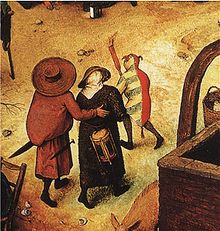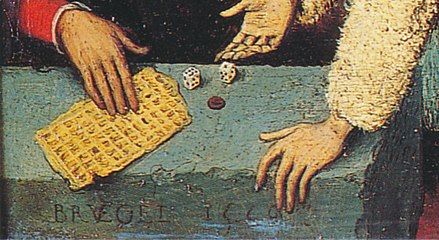The battle between carnival and fasting

|
| The battle between carnival and fasting |
|---|
| Pieter Bruegel the Elder , around 1559 |
| Oil on oak |
| 118 × 164.5 cm |
| Art History Museum |
The fight between carnival and fasting is a 118 cm × 164.5 cm oil painting by Pieter Bruegel the Elder from 1559 . As a fight between carnival and fasting , it belongs to the Bruegel collection of the Kunsthistorisches Museum in Vienna , room 10.
construction
As is customary in early works by Bruegel, the viewer looks from above onto a densely populated square. This is divided into two parts: Carnival customs are shown on the left, Lent on the right . Two taverns on the left edge and a cathedral with an Ash Wednesday procession stand opposite each other as opposing poles, as do the two figures on the lower edge who fight each other with meat skewers and baking shovels . In order to create more space for the numerous figures, Bruegel sets the horizon line unrealistically high, so that only a narrow strip of sky remains. In addition, the space against the background appears to be folded up like a stage and the figure size decreases slowly and evenly. This is reminiscent of medieval altar paintings, where the painters used this for secondary scenes located in spatial views. Bruegel now uses this technique for a complete picture.
Interpretations
The fight between Prinz Karneval (Herr Fastnacht) and Frau Fasten is a parody of a jousting game . Prince Carnival sits on a barrel and is pulled on a load sledge . A pig's head is stuck on his “weapon”, the meat skewer. Frau Fasten sits on a pew, which stands on a processional cart drawn by a monk and a maid. She wears a hairy penitential robe and a beehive on her head. There are two pegs on her “weapon”, a baking shovel. Individual groups of figures break through the contrast: on the carnival side, beggars who are in need, on the fasting side, children play.
Three figures in the center of the picture also fall out of the scheme: There a couple follows a fool who shines a torch on the bright day. This could be an allusion to the “upside down world” in which Protestants and Catholics feud, as in the Netherlands in Bruegel's time. Prince Carnival and Ms. Fasten are mock images of the denominations: Protestants had abolished Lent because, in their opinion, neither penance, abstinence nor good works justify people before God, but only faith. This brought them on the Catholic side the suspicion of being morally and morally depraved. On the other hand, the demonstrative outward piety of the Catholics made them appear particularly ascetic.
Another possibility of interpretation, which does not exclude the first, is that the artist is alluding to Augustine's two-state model . According to this, the world consists of a devil state ( civitas diaboli ) and a god state ( civitas dei ). The Carnival So stood for sinful pleasures and the Lenten penance for it.
Classification and assignment
This type of image, founded by Bruegel, is known as the “encyclopedic diagram”, as the artist creates as large an overview as possible (e.g. of contemporary customs) in a limited space. Other examples are The Dutch Proverbs and The Children's Games . The picture is signed and dated in the lower left corner on a stone that two dice players use: BRVEGEL (V and E ligated ) 1559.
In 1558 Hieronymus Cock , who also published Bruegel's drawings, published the etching Kampf von Lasten und Karneval after Frans Hogenberg . This etching anticipates much of Bruegel's painting.
history
The painting probably came into Habsburg possession under Rudolf II. It has been in the picture gallery since 1748, previously in the treasury.
literature
- Elke M. Schutt-Kehm: Pieter Bruegels d. Ä. “The battle of the carnival against fasting” as a source of folklore research (= Artes populares, 7). Lang, Frankfurt a. M. u. a., 1983, ISBN 978-3-8204-7605-7 .
- Werner Mezger : Swabian-Alemannic Carnival: cultural heritage and living tradition. Konrad Theiss Verlag, Darmstadt, 2015, ISBN 978-3-8062-2947-9 , pp. 19-21.
Web links
Individual evidence
- ^ Christian Vöhringer: Pieter Bruegel. 1525 / 30-1569. Tandem Verlag (hfullmann imprint), Potsdam, 2007, ISBN 978-3-8331-3852-2 , p. 40.
- ^ Rose-Marie, Rainer Hagen: Pieter Bruegel. 1525 / 30-1569. Taschen Verlag, Cologne et al., 1999, ISBN 3-8228-6590-7 , p. 48.
- ^ Philipp Pötz: The carnival picture of Pieter Bruegel the Elder: Commentary on the religious situation of his time? (pdf, 896 kB) Faculty of History and Cultural Studies at the University of Vienna, archived from the original on November 22, 2010 ; Retrieved June 17, 2011 .
- ↑ Hans Sigmund: The fight of Mr. Fastnacht against Mrs. Fasten. In: badische-zeitung.de . February 3, 2009, archived from the original on August 2, 2009 ; Retrieved September 3, 2009 .
- ↑ a b Fight between carnival and fasting. In: Kunsthistorisches Museum Wien image database. Archived from the original on November 11, 2014 ; accessed on September 9, 2019 .
- ^ Christian Vöhringer: Pieter Bruegel the Elder: Painting, everyday life and politics in the 16th century: a biography . Reclam, Stuttgart, 2013, ISBN 978-3-15-010898-7 , p. 67.





